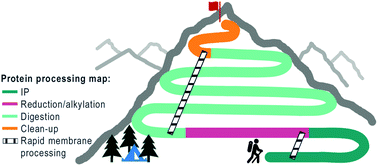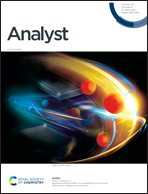Improving the throughput of immunoaffinity purification and enzymatic digestion of therapeutic proteins using membrane-immobilized reagent technology†
Abstract
Continued interest in protein therapeutics has motivated the development of improved bioanalytical tools to support development programs. LC-MS offers specificity, sensitivity, and multiplexing capabilities without the need for target-specific reagents, making it a valuable alternative to ligand binding assays. Immunoaffinity purification (IP) and enzymatic digestion are critical, yet extensive and time-consuming components of the “gold standard” bottom-up approach to LC-MS-based protein quantitation. In the present work, commercially available technology, based on membrane-immobilized reagents in spin column and plate format, is applied to reduce IP and digestion times from hours to minutes. For a standard monoclonal antibody, the lower limit of quantitation was 0.1 ng μL−1 compared to 0.05 ng μL−1 for the standard method. A pharmacokinetics (PK) study dosing Herceptin in rat was analyzed by both the membrane and the standard method with a total sample processing time of 4 h and 20 h, respectively. The calculated concentrations at each time point agreed within 8% between both methods, and PK values including area under the curve (AUC), half-life (T1/2), mean residence time (MRT), clearance (CL), and volume of distribution (Vdss) agreed within 6% underscoring the utility of the membrane methodology for quantitative bioanalysis workflows.



 Please wait while we load your content...
Please wait while we load your content...